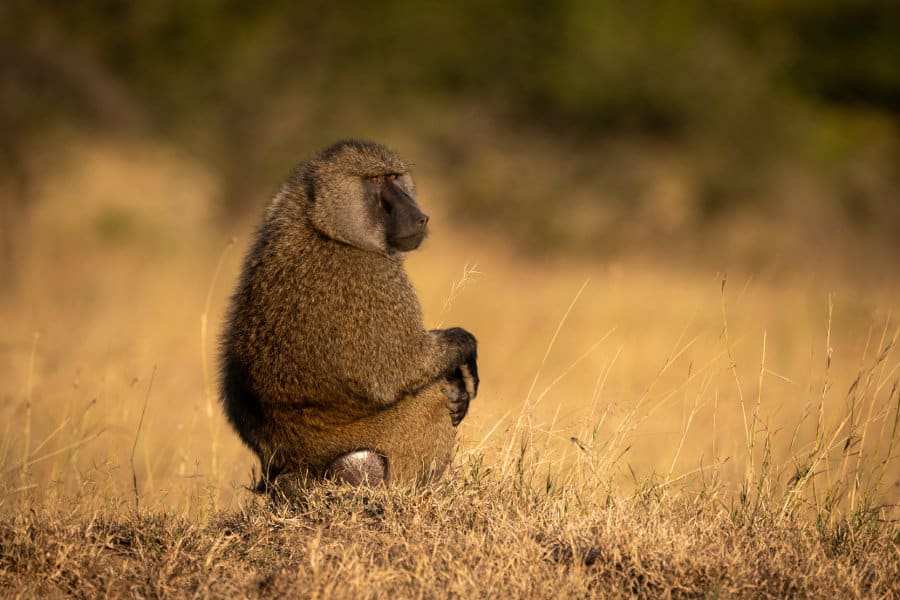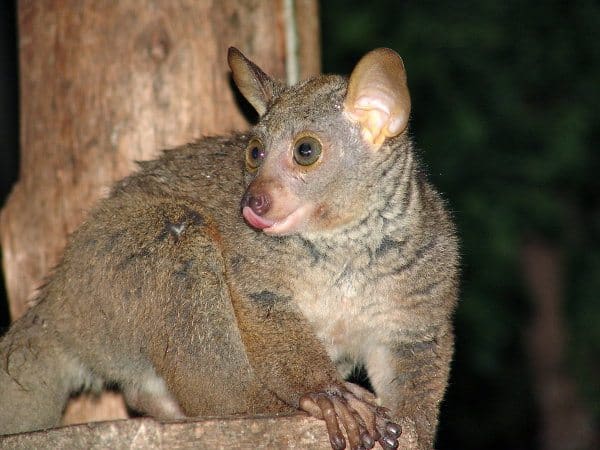Olive baboons, sometimes referred to as savanna baboons, survive and thrive in an extreme diversity of habitats. Their range covers 25 countries in central sub-Saharan Africa.
These incredible primates have learned to adapt to wildly different environments. They have conquered habitats from forests to deserts and savanna grasslands.
They are expert foragers, able to identify food with high nutritional value, and utilizing clever methods to access it. They also have advanced social skills. This allows them to create complex social bonds and unusual symbiotic relationships.
Check out this guide on everything you need to know about the fascinating olive baboon.
Anubis Baboon Appearance

Olive baboons have a similar dog-like face to their relatives, the chacma baboon. They are strong and sturdy animals with bulky bodies and very long tails.
When you see them, you may think that by some strange phenomenon, every olive baboon’s tail has suffered some sort of injury. This is because it is stiff from its body up to the first quarter and then droops.
Their faces have a long, square muzzle with powerful jaws that house impressive canines. The baboons have a prominent brow ridge and close-set, sunken eyes.
The olive baboon’s fur is predominantly grey with specks of black and yellow. This combination of colors lends the baboon its ‘olive’ name as it looks green-gray from a distance. Males boast a mane of long hair.
This is one of the largest monkey species with an average height of 85 cm and an average weight of 24 kg in males and 14 kg in females.
The Makeup of Baboon Society
Olive baboons have a fascinating group dynamic and interaction with one another. As with many primates, the troop has a multi-faceted web of relationships and hierarchies.
Social behavior
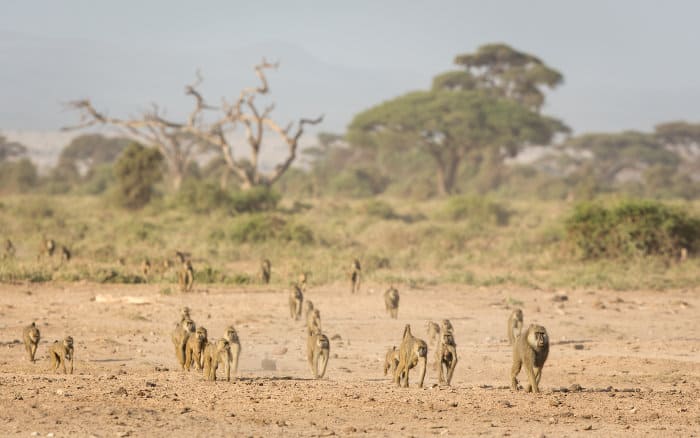
The structured troop hierarchy involves a constant tug-of-war for dominance between males. However, females have an important position in the troop as permanent members. When a new male shows interest in joining a group, it is the females he must win over.
Females will often lead the group to new areas because they know the territory well. In comparison, males may take the lead when food is scarce and the troop is searching for new feeding grounds.
When a ‘family’ is moving, the dominant males take a position in the center of the group, with females and babies forming the outer ring. Low-ranking males and adolescents are essentially the cannon fodder, moving at the group’s outer edge to provide protection from predators. Or rather, providing a meal for predators.
The importance of grooming
Grooming is an essential aspect of relationships and a harmonious olive baboon society. This is a present feature of many primate groups.
The baboons meticulously groom each other’s fur, picking out insects and preventing hair from getting into wounds. This is not only hygienic, it’s also used to create bonds and relax. Who doesn’t love getting a head scratch and a back tickle?
Nurturing females
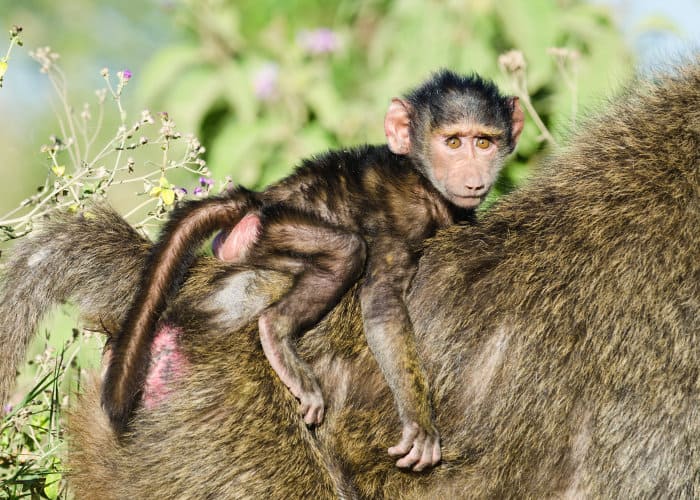
The gestation period of an olive baboon is six months and at birth, the baby is relatively dependent on its mother. The mothers are fiercely protective over their young, carrying the baby at their breast for the first few weeks and then later on their backs.
Babies start eating solid food at around six months, which is relatively old in the animal kingdom.
It is not only the mother that has an undying affection for their new babies, all the females in the troop feel the same. Lip-smacking, swooning females from the troop, desperate to groom the newcomer, will be there to greet a new baby. This happens regardless of the mother’s position within the troop.
Communicative Baboon Faces
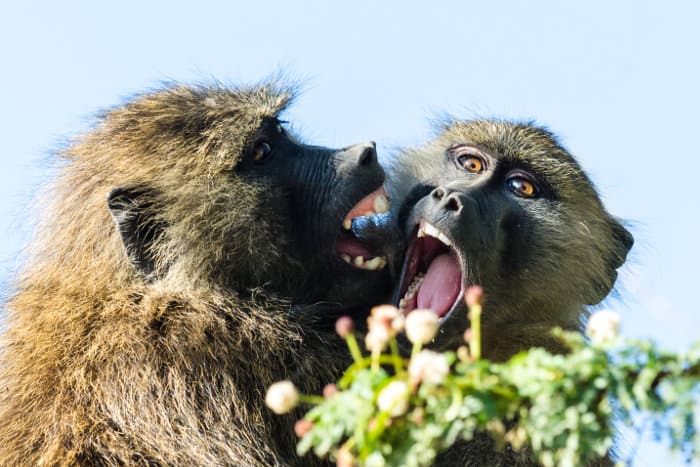
Olive baboons have complex communication, using gestures and body language as well as facial expressions and vocalizations. Sounds familiar?
Using these techniques, they can communicate subtle messages that extend past the usual ‘WARNING’ or mating signals we see among other animals.
The complexity of this communication is impressive. Olive baboons do not use only one type of bark, for example. They have a loud and shrill bark to express incoming danger. And a dog-like bark to communicate with individuals separated from the group.
There’s nothing like a little lip-smacking combined with a friendly ‘mooning’ of the buttocks to extend an invitation of friendship.
Or a full erection, otherwise known as a ‘penile display‘, to assert dominance by the guarding male baboon.
This is just the tip of the iceberg of olive baboon communication, but it indicates just how cognizant these animals are.
Omnivorous Olive Baboon Diet
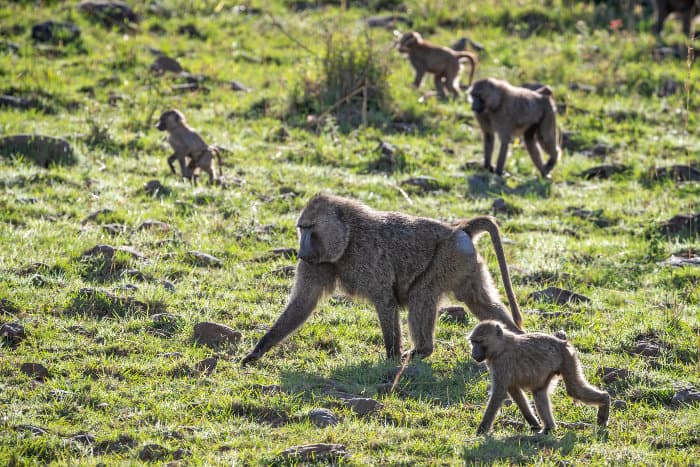
These baboons are omnivores and opportunists. They are exceptionally skilled foragers and spend most of their time moving through their habitat searching for food. These expert abilities have allowed the baboons to survive in a range of environments.
Their diet changes with the seasons and environment. In tropical settings, fruit, young leaves, and flowers are on the menu.
In savanna habitats, Grewia berries and fresh grasses are the food of choice. In arid areas or when the dry season hits, the baboons work hard to dig out roots and tubers, supplemented with seeds.
They are not true carnivores and rarely hunt. However, as opportunists, if they stumble upon a carcass, they’ll happily eat their fill. These baboons will also munch on insects and eggs, finding nutrition wherever possible.
They are smart eaters, choosing foods with high nutritional content, and developing methods to find and access them. For example, they have learned to rub prickly pears continuously on the ground to remove the spines.
Olive Baboon Predators
The natural predators of olive baboons include big cats, such as leopard and lion, as well as crocodiles, hyenas, and wild dogs. In some areas, chimpanzees also pose a threat to the baboons.
However, the conflict between baboons and humans who live in close proximity is a massive threat to the olive baboon population.
Most people who visit Africa leave with a naughty baboon story. There are many ruined picnics and campsites raided by the cheeky monkeys.
This proves a problem for farmers who share a habitat with olive baboons as crops get annihilated by the pillaging baboons. This leads to local communities trapping and killing the olive baboons.
Another unnatural threat is habitat loss due to expanding agriculture.
It’s not all doom and gloom for the olive baboon, though. The population is at a ‘Least Concern’ rank and is not currently under much threat.
Olive Baboon and African Elephant Relationship
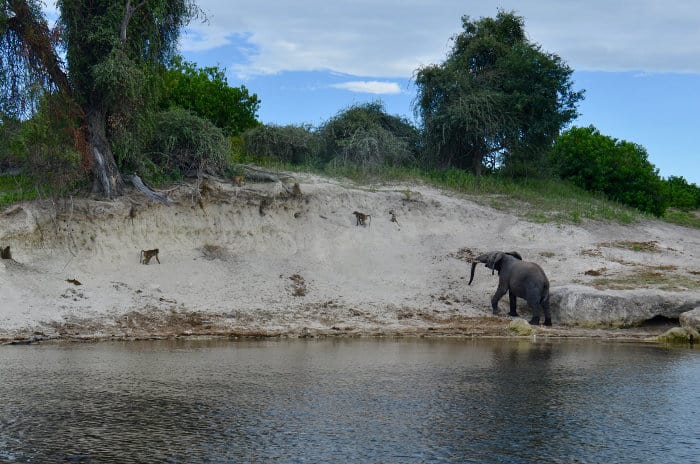
Olive baboons share an interesting symbiotic relationship with African giants, elephants. This relationship especially takes place in desert regions such as Ethiopia and Eritrea.
The baboons have identified the elephants’ knack for finding and accessing water in barren areas. Elephants dig deep holes in the sand, breaking through to groundwater and creating a well. Olive baboons follow the elephants and gain access to these small water sources.
The wise elephants know that nothing comes for free in the wild. In return, the baboons, perched high in the treetops, serve as an early alarm system to warn of any incoming danger. This relationship is crucial to the olive baboon’s survival in the desert.
Olive Baboon Facts
These primates are incredibly interesting, here are a few more facts to prove it:
- Olive baboons can live up to 30 years in the wild yet rarely do. Surviving in the wild is no easy feat and few baboons reach this age.
- The olive baboon’s buttocks feature ischial callosities, a fancy name for rough patches of backside skin. These patches, positioned on either side of the buttocks, are the reason that baboons can sit upright on tree branches and not fall.
- The baboons have a ‘saving it for later’ pouch in their cheeks where they can store food.
- Troops can range between 15 and 150 members.
- Females remain in one troop for their entire lives while males come and go, usually in five-year frames. This is an incredibly effective way of avoiding incest and allowing gene diversity within the olive baboon population.
- Alpha females are important peace-keepers within their own family and the wider troop.
- They are crucial to the ecosystem as they spread seeds. The baboons eat a wide variety of fruit and plant and tree species. In Ivory Coast, the olive baboons eat no less than 79 different plant species. They then disperse throughout the environment through feces.
- Another ecological contribution is their role in aerating soil when they dig for food.
- They spend most of their time on the ground foraging for food but will sleep in trees or on cliffs, which keeps them safe from predators.
- Female and male olive baboons are polygamous.
The Fascinating Lives of Olive Baboons

The olive baboon’s habitat and population has a wider reach throughout Africa, and in more countries, than any other baboon. With unparalleled survival skills and complex relationships, they have proved to be a highly adaptable species.
With such a far-reaching range, you have a great chance of seeing these interesting baboons when you book an African safari. Try to decipher their advanced communication and look out for the troop’s alpha when you spot them!
